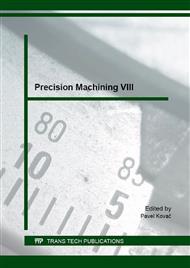[1]
G. Krolczyk, S. Legutko, Investigations Into Surface Integrity in the Turning Process of Duplex Stainless Steel, Transactions of FAMENA. 38, 2 (2014) 77-82.
Google Scholar
[2]
G. Krolczyk, S. Legutko, P. Nieslony, M. Gajek, Study of the surface integrity microhardness of austenitic stainless steel after turning, Tehnički Vjesnik - Technical Gazette. 21, 6 (2014) 1307-1311.
Google Scholar
[3]
H. Iancau, P. Bere, M. Borzan, L. Hancu, A. Crai, The influence of reinforced materials and manufacturing procedures on the mechanical characteristics of polymeric composite materials, Materiale Plastice. 45, 3 (2008) 251-256.
Google Scholar
[4]
A. Popescu, L. Hancu, P. Bere, Research concerning the optimum extrusion temperature for reinforced polyamide, Applied Mechanics and Materials. 371 (2013) 394-398.
DOI: 10.4028/www.scientific.net/amm.371.394
Google Scholar
[5]
E. E. Feldshtein, L. N. Dyachkova, On the properties and tribological behaviors of P/M iron based composites reinforced with ultrafine particulates, Composites Part B: Engineering. 58 (2014) 16-24.
DOI: 10.1016/j.compositesb.2013.10.015
Google Scholar
[6]
G.M. Krolczyk, P. Nieslony, J.B. Krolczyk, I. Samardzic, S. Legutko, S. Hloch, S. Barrans, R.W. Maruda, Influence of argon pollution on the weld Surface Morphology, Measurement. 70 (2015) 203 – 213.
DOI: 10.1016/j.measurement.2015.04.001
Google Scholar
[7]
A. Glowacz, Diagnostics of direct current machine based on analysis of acoustic signals with the use of symlet wavelet transform and modified classifier based on words, Eksploatacja i Niezawodnosc-Maintenance and Reliability. 16, 4 (2014) 554-558.
Google Scholar
[8]
A. Glowacz, A. Glowacz, P. Korohoda, Recognition of monochrome thermal images of synchronous motor with the application of binarization and nearest mean classifier, Archives of Metallurgy and Materials. 59, 1 (2014) 31-34.
DOI: 10.2478/amm-2014-0005
Google Scholar
[9]
C. Guarnaccia, J. Quartieri, A. Ruggiero, Acoustical noise study of a factory: Indoor and outdoor simulations integration procedure, International Journal of Mechanics. 8, 1 (2014) 298-306.
Google Scholar
[10]
W. Kaplonek, K. Nadolny, The diagnostics of abrasive tools after internal cylindrical grinding of hard-to-cut materials by means of a laser technique using imaging and analysis of scattered light, Arabian Journal for Science and Engineering. 38, 4 (2013).
DOI: 10.1007/s13369-012-0374-3
Google Scholar
[11]
M. Duspara, K. Sabo, A. Stoić, Acoustic emission as tool wear monitoring, Tehnički Vjesnik - Technical Gazette, 21 (2014) 1097-1101.
Google Scholar
[12]
M. Sadilek, J. Kratochvil, J. Petru, R. Cep, T. Zlamal, D. Stancekova, Cutting tool wear monitoring with the use of impedance layers, Tehnički Vjesnik - Technical Gazette. 21 (2014) 639-644.
Google Scholar
[13]
P. Hreha, A. Radvanska, L. Knapcikova, G. Krolczyk, S. Legutko, J. Krolczyk, S. Hloch, P. Monka, Roughness parameters calculation by means of on-line vibration monitoring emerging from AWJ interaction with material, Metrology and Measurement Systems. 22, 2 (2015).
DOI: 10.1515/mms-2015-0024
Google Scholar
[14]
S. Krile, D. Perakovic, Load control for overloaded MPLS/DiffServ networks during SLA negotiation, Int. J. Communications, Network and System Sciences. (2009) 422-432.
DOI: 10.4236/ijcns.2009.25047
Google Scholar
[15]
K. Arai, R. Mardiyanto, Autonomous control of eye based electric wheel chair with obstacle avoidance and shortest path findings based on Dijkstra algorithm, International Journal of Advanced Computer Science and Applications. 2, 12 (2011) 19-25.
DOI: 10.14569/ijacsa.2011.021203
Google Scholar
[16]
M. Xu, Y. Liu, Q. Huang, Y. Zhang, G. Luan, An improved Dijkstra shortest path algorithm for sparse network, in: Applied Mathematics and Computation. 185 (2007) 247-254.
DOI: 10.1016/j.amc.2006.06.094
Google Scholar
[17]
O. Nowers, D.J. Duxbury, J. Zhang, B.W. Drinkwater, Novel ray-tracing algorithms in NDE: Application of Dijkstra and A* algorithms to the inspection of an anisotropic weld, NDT&E International. 61 (2014) 58-66.
DOI: 10.1016/j.ndteint.2013.08.002
Google Scholar
[18]
D. Berovic, R. Vinter, The application of dynamic programming to optimal inventory control, IEEE Transactions on Automatic Control. 49, 5 (2004) 676-685.
DOI: 10.1109/tac.2004.826719
Google Scholar
[19]
Y. Deng, Y. Chen, Y. Zhang, S. Mahadevan, Fuzzy Dijkstra algorithm for shortest path problem under uncertain environment, Applied Soft Computing, 12 (1012) 1231-1237.
DOI: 10.1016/j.asoc.2011.11.011
Google Scholar
[20]
E. Dijkstra, A note on two problems in connexion with graphs, Numerische Mathematik. 1 (1959) 269-71.
DOI: 10.1007/bf01386390
Google Scholar


